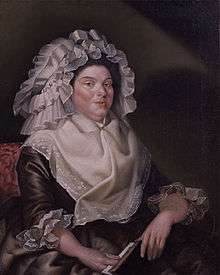Ruffle
In sewing and dressmaking, a ruffle, frill, or furbelow is a strip of fabric, lace or ribbon tightly gathered or pleated on one edge and applied to a garment, bedding, or other textile as a form of trimming.[1]

A flounce is a particular type of fabric manipulation that creates a similar look but with less bulk. The term derives from earlier terms of frounce or fronce.[2] A wavy effect is achieved without gathers or pleats by cutting a curved strip of fabric and applying the inner or shorter edge to the garment. The depth of the curve as well as the width of the fabric determines the depth of the flounce. A godet is a circle wedge that can be inserted into a flounce to further deepen the outer floating wave without adding additional bulk at the point of attachment to the body of the garment, such as at the hemline, collar or sleeve.
Ruffles appeared at the draw-string necklines of full chemises in the 15th century, evolved into the separately-constructed ruff of the 16th century. Ruffles and flounces remained a fashionable form of trim, off-and-on into modern times.[3]
Notes
- Caulfield, S.F.A. and B.C. Saward, The Dictionary of Needlework, 1885, facsimile edition, Blaketon Hall, 1989, p. 428
- Caulfield and Saward, The Dictionary of Needlework, p. 218
- For styles and construction of ruffles, frills and flounces through the centuries, see the Arnold, Baumgarten and Tozer volumes listed below
References
- Arnold, Janet: Patterns of Fashion: the cut and construction of clothes for men and women 1560–1620, Macmillan 1985. Revised edition 1986. (ISBN 0-8967-6083-9)
- Baumgarten, Linda: What Clothes Reveal: The Language of Clothing in Colonial and Federal America, Yale University Press, 2002. ISBN 0-300-09580-5
- Oxford English Dictionary
- Picken, Mary Brooks: The Fashion Dictionary, Funk and Wagnalls, 1957. (1973 edition ISBN 0-308-10052-2)
- Tozer, Jane and Sarah Levitt, Fabric of Society: A Century of People and their Clothes 1770–1870, Laura Ashley Press, ISBN 0-9508913-0-4